
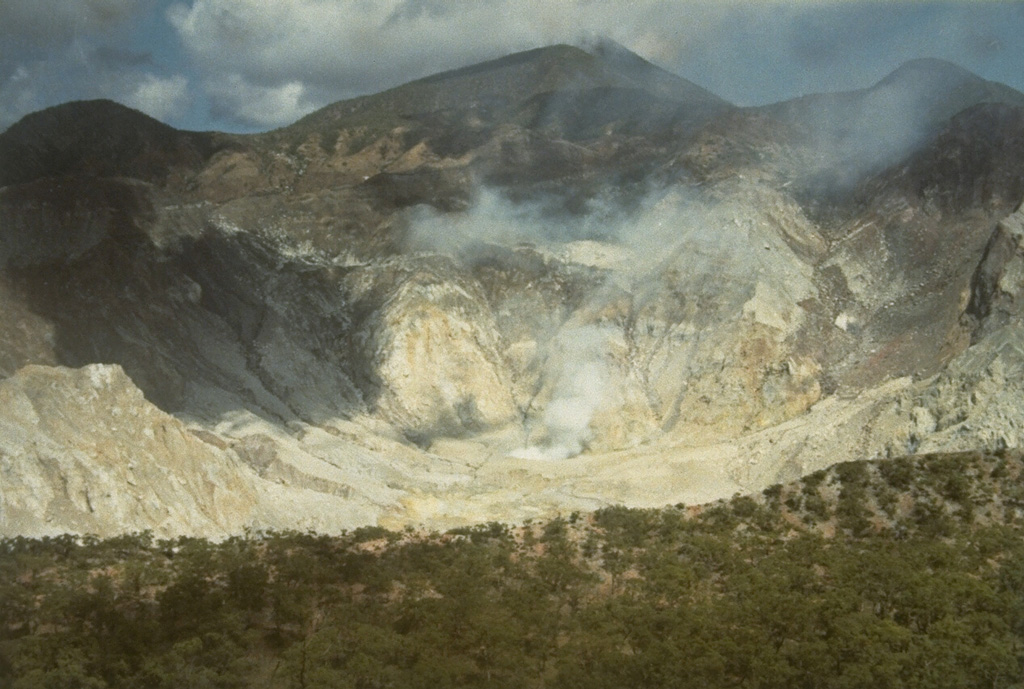
PVMBG reported that white emissions rose 10-50 m above the summit of Sirung and drifted NE, E, and SE. Seismicity was relatively low and showed a consistent decrease since July 2021. As a result, the Alert Level was lowered to 1 (on a scale of 1-4) at 1800 on 1 April.
Source: Pusat Vulkanologi dan Mitigasi Bencana Geologi (PVMBG, also known as CVGHM)
Phreatic eruption on 21 July 2021
Sirung, located at the S end of Pantar Island, is truncated by a 2-km-wide caldera with a floor that often contains one or more small lakes. Fourteen eruptions have been documented since 1852, often with phreatic activity, including its most recent one that occurred during 7-8 July 2015; activity was characterized by a small, short-lived ash eruption (BGVN 41:02). This report updates information through September 2021 and includes a short eruption during July 2021, based on information from the Pusat Vulkanologi dan Mitigasi Bencana Geologi (PVMBG, also known as CVGHM, or the Center of Volcanology and Geological Hazard Mitigation) and the Darwin Volcanic Ash Advisory Center (VAAC).
No significant activity has been reported since an ash plume on 7 and 8 July 2015. Low seismicity was recorded during April through June 2021; a minor increase in tremor amplitude lasted 10 hours on 21 July, though there were no volcanic earthquakes indicative of magma movement. However, the Volcano Alert Level was raised to 2 (on a scale of 1-4) later that day. Following this increase in seismicity, a phreatic eruption was recorded at 1644 through 1800 on 21 July, which produced a white-and-gray ash plume that rose 2 km above the summit and drifted N (figure 1). Weak, intermittent, white gas-and-steam emissions continued to rise up to 500 m above the summit through August, according to PVMBG; some gas-and-steam emissions were noted during September.
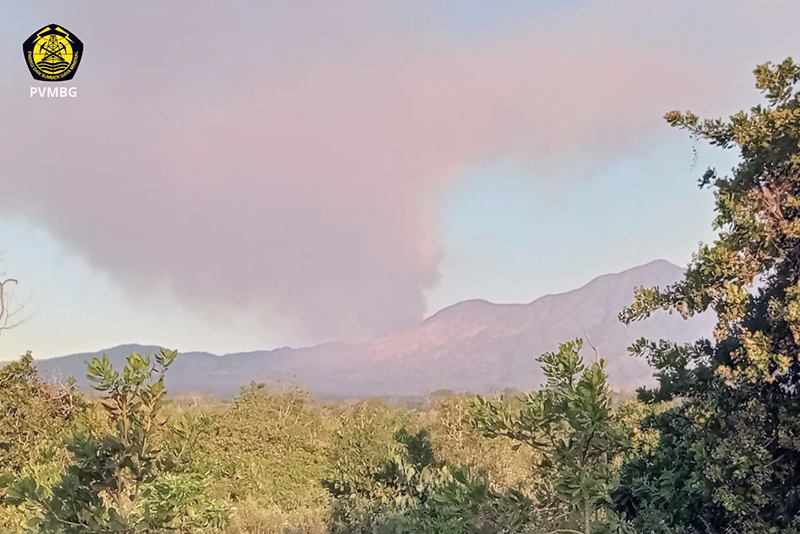 |
Figure 1. Webcam image of the phreatic eruption at Sirung on 21 July 2021 that consisted of a white-and-gray ash plume. Courtesy of PVMBG. |
Information Contacts: Pusat Vulkanologi dan Mitigasi Bencana Geologi (PVMBG, also known as Indonesian Center for Volcanology and Geological Hazard Mitigation, CVGHM), Jalan Diponegoro 57, Bandung 40122, Indonesia (URL: http://www.vsi.esdm.go.id/); Darwin Volcanic Ash Advisory Centre (VAAC), Bureau of Meteorology, Northern Territory Regional Office, PO Box 40050, Casuarina, NT 0811, Australia (URL: http://www.bom.gov.au/info/vaac/).
2022: March
2021: July
2015: July
2012: May
| June
| September
2004: May
PVMBG reported that white emissions rose 10-50 m above the summit of Sirung and drifted NE, E, and SE. Seismicity was relatively low and showed a consistent decrease since July 2021. As a result, the Alert Level was lowered to 1 (on a scale of 1-4) at 1800 on 1 April.
Source: Pusat Vulkanologi dan Mitigasi Bencana Geologi (PVMBG, also known as CVGHM)
PVMBG reported that a phreatic eruption at Sirung was recorded at 1644 on 21 July. A white-and-gray ash plume rose 2 km above the summit and drifted N. The report noted that the event was preceded by an increase in tremor amplitude that lasted about 10 hours; no volcanic earthquakes indicating magma movement were recorded and tremor amplitude did not notably increase. The Alert Level was raised to 2 (on a scale of 1-4), with visitors and tourists prohibited within a 1.5 km radius of Sirung.
Source: Pusat Vulkanologi dan Mitigasi Bencana Geologi (PVMBG, also known as CVGHM)
Based on analyses of satellite imagery and wind data, the Darwin VAAC reported that on 8 July an ash plume from Sirung drifted 55 km W at an altitude of 1.5 km (5,000 ft) a.s.l.
Source: Darwin Volcanic Ash Advisory Centre (VAAC)
Based on analyses of satellite imagery and wind data, the Darwin VAAC reported that on 7 July an ash plume from Sirung rose to an altitude of 1.5 km (5,000 ft) a.s.l. and drifted 85 km SW.
Source: Darwin Volcanic Ash Advisory Centre (VAAC)
CVGHM reported that on 7 September the Alert Level for Sirung was lowered from 2 to 1 (on a scale of 1-4).
Source: Pusat Vulkanologi dan Mitigasi Bencana Geologi (PVMBG, also known as CVGHM)
CVGHM reported that during 1-13 June diffuse white plumes from Sirung rose 30-70 m above the crater. A sulfur odor was occasionally noted at the Sirung observation post. Based on seismic activity and visual observations, on 15 June CVGHM reiterated that the Alert Level remained at 2 (on a scale of 1-4).Visitors and tourists were not permitted to go within a 1.5 km radius of Sirung.
Source: Pusat Vulkanologi dan Mitigasi Bencana Geologi (PVMBG, also known as CVGHM)
CVGHM reported that during 13-18 May diffuse white plumes from Sirung rose 10-50 m above the crater. Seismicity was elevated during 12-17 May then decreased through 23 May, although levels remained above background. On 25 May the Alert Level was lowered to 2 (on a scale of 1-4).
Source: Pusat Vulkanologi dan Mitigasi Bencana Geologi (PVMBG, also known as CVGHM)
CVGHM reported that on 8 May a three-hour long ash eruption from Sirung was accompanied by loud sounds and incandescence that reached 10 m above the crater. An ash plume rose 3.5 km above the crater and drifted N, producing ashfall up to 4 mm thick near the crater. During 9-12 May white plumes rose 30-50 m above the crater. A sulfur odor was reported in areas up to 3 km away on 12 May. That same day CVGHM raised the Alert Level to 3 (on a scale of 1-4) and recommended that visitors not approach the volcano within a 2.5 km radius.
Based on a report from a ground-based observer and analyses of satellite imagery, the Darwin VAAC noted that on 12 May an ash plume rose to an altitude of 3 km (10,000 ft) a.s.l. and drifted about 95 km SW.
Sources: Pusat Vulkanologi dan Mitigasi Bencana Geologi (PVMBG, also known as CVGHM); Darwin Volcanic Ash Advisory Centre (VAAC)
According to DVGHM, the news reports of an eruption at Sirung around 13 May were false. There was no activity at the volcano.
Source: Pusat Vulkanologi dan Mitigasi Bencana Geologi (PVMBG, also known as CVGHM)
According to a news article, Sirung began erupting "smoke and dust" around 13 May. A local government official reportedly said that hundreds of residents were evacuated from within 1 or 2 kilometers of the volcano. There were no reports of injuries or damage.
Source: ABC News - Australian Broadcasting Corporation
Reports are organized chronologically and indexed below by Month/Year (Publication Volume:Number), and include a one-line summary. Click on the index link or scroll down to read the reports.
Fumaroles and crater lake normal after earthquake
A VSI observer visited the volcano on 12 December. Fumaroles and the crater lake were normal and showed no evidence of increased activity that might be attributed to the M 6.5 earthquake of 26 November (preliminary epicenter 8.35°S, 124.25°E). The only notable change in the crater was a fresh landslide scar that may have resulted from the earthquake.
Information Contacts: VSI.
Small short-lived ash eruptions in May 2012 and July 2015
Small eruptions from Sirung were reported in May 2012 and July 2015. These were the first reported eruptions since 1970 from the volcano at the southern end of Pantar island, which sometimes has a crater lake and a history of phreatic activity.
Activity during 2012. The Indonesian Centre for Volcanology and Geological Hazard Mitigation (CVGHM) reported that on 8 May 2012 a three-hour long ash eruption that was accompanied by loud sounds and incandescence material that reached 10 m above the crater. An ash plume rose 3.5 km above the crater and drifted N, causing ashfall up to 4 mm thick near the crater. During 9-12 May white plumes rose 30-50 m above the crater.
On 12 May an ash plume rose to an altitude of 3 km and drifted about 95 km SW, and a sulfur odor was reported in areas up to 3 km away. That same day CVGHM raised the Alert Level to 3 (on a scale of 1-4) and recommended that visitors not approach the volcano within a 2.5 km radius. During 13-18 May 2012 diffuse white plumes rose 10-50 m above the crater. Seismicity was elevated during 12-17 May then decreased through 23 May, although levels remained above background. On 25 May the Alert Level was lowered to 2 (on a scale of 1-4).
CVGHM reported that during 1-13 June 2012 diffuse white plumes rose 30-70 m above the crater. A sulfur odor was occasionally noted at the Sirung observation post. Based on seismic activity and visual observations, on 15 June CVGHM reiterated that the Alert Level remained at 2 (on a scale of 1-4). On 7 September 2012 the Alert Level was lowered from 2 to 1 (on a scale of 1-4).
Activity during 2015. Based on analyses of satellite imagery and wind data, the Darwin VAAC reported that on 7 July 2015 an ash plume from Sirung rose to an altitude of 1.5 km and drifted 85 km SW. On 8 July an ash plume at an altitude of 1.5 km drifted 55 km W.
Information Contacts: Pusat Vulkanologi dan Mitigasi Bencana Geologi (PVMBG, also known as Indonesian Center for Volcanology and Geological Hazard Mitigation, CVGHM), Jalan Diponegoro 57, Bandung 40122, Indonesia (URL: http://www.vsi.esdm.go.id/); Darwin Volcanic Ash Advisory Centre (VAAC), Bureau of Meteorology, Northern Territory Regional Office, PO Box 40050, Casuarina, NT 0811, Australia (URL: http://www.bom.gov.au/info/vaac/).
Phreatic eruption on 21 July 2021
Sirung, located at the S end of Pantar Island, is truncated by a 2-km-wide caldera with a floor that often contains one or more small lakes. Fourteen eruptions have been documented since 1852, often with phreatic activity, including its most recent one that occurred during 7-8 July 2015; activity was characterized by a small, short-lived ash eruption (BGVN 41:02). This report updates information through September 2021 and includes a short eruption during July 2021, based on information from the Pusat Vulkanologi dan Mitigasi Bencana Geologi (PVMBG, also known as CVGHM, or the Center of Volcanology and Geological Hazard Mitigation) and the Darwin Volcanic Ash Advisory Center (VAAC).
No significant activity has been reported since an ash plume on 7 and 8 July 2015. Low seismicity was recorded during April through June 2021; a minor increase in tremor amplitude lasted 10 hours on 21 July, though there were no volcanic earthquakes indicative of magma movement. However, the Volcano Alert Level was raised to 2 (on a scale of 1-4) later that day. Following this increase in seismicity, a phreatic eruption was recorded at 1644 through 1800 on 21 July, which produced a white-and-gray ash plume that rose 2 km above the summit and drifted N (figure 1). Weak, intermittent, white gas-and-steam emissions continued to rise up to 500 m above the summit through August, according to PVMBG; some gas-and-steam emissions were noted during September.
 |
Figure 1. Webcam image of the phreatic eruption at Sirung on 21 July 2021 that consisted of a white-and-gray ash plume. Courtesy of PVMBG. |
Information Contacts: Pusat Vulkanologi dan Mitigasi Bencana Geologi (PVMBG, also known as Indonesian Center for Volcanology and Geological Hazard Mitigation, CVGHM), Jalan Diponegoro 57, Bandung 40122, Indonesia (URL: http://www.vsi.esdm.go.id/); Darwin Volcanic Ash Advisory Centre (VAAC), Bureau of Meteorology, Northern Territory Regional Office, PO Box 40050, Casuarina, NT 0811, Australia (URL: http://www.bom.gov.au/info/vaac/).
This compilation of synonyms and subsidiary features may not be comprehensive. Features are organized into four major categories: Cones, Craters, Domes, and Thermal Features. Synonyms of features appear indented below the primary name. In some cases additional feature type, elevation, or location details are provided.
Synonyms |
||||
| Siroeng | Pantar Api | Sereh, Gunung | Delaki, Gunung | ||||
Cones |
||||
| Feature Name | Feature Type | Elevation | Latitude | Longitude |
|
Topaki, Gunung
Delaki |
Stratovolcano | 1320 m | 8° 31' 9" S | 124° 6' 20" E |
Craters |
||||
| Feature Name | Feature Type | Elevation | Latitude | Longitude |
|
Anunggola
Anoengola |
Crater | 794 m | ||
| Kalikiir | Crater | 1020 m | ||
| Northern Crater | Crater | 634 m | 8° 29' 26" S | 124° 8' 11" E |
| Sombutang | Crater | 903 m | ||
|
Tamoyang
Tamojang |
Crater | 742 m | ||
|
|
||||||||||||||||||||||||
There is data available for 11 confirmed Holocene eruptive periods.
2021 Jul 21 - 2021 Jul 21 Confirmed Eruption Max VEI: 1
| Episode 1 | Phreatic Episode | |||||||||||||||||||||||||
|---|---|---|---|---|---|---|---|---|---|---|---|---|---|---|---|---|---|---|---|---|---|---|---|---|---|
| 2021 Jul 21 - 2021 Jul 21 | Evidence from Observations: Reported | ||||||||||||||||||||||||
| A phreatic eruption was recorded at 1644 on 21 July 2021. A white-and-gray ash plume rose 2 km above the summit and drifted N. | |||||||||||||||||||||||||
|
List of 3 Events for Episode 1
| |||||||||||||||||||||||||
2015 Jul 7 - 2015 Jul 8 Confirmed Eruption Max VEI: 1
| Episode 1 | Eruption Episode | vents within the caldera | ||||||||||||||||||||||||
|---|---|---|---|---|---|---|---|---|---|---|---|---|---|---|---|---|---|---|---|---|---|---|---|---|---|
| 2015 Jul 7 - 2015 Jul 8 | Evidence from Observations: Reported | ||||||||||||||||||||||||
|
List of 3 Events for Episode 1 at vents within the caldera
| |||||||||||||||||||||||||
2012 May 8 - 2012 May 12 Confirmed Eruption Max VEI: 2
| Episode 1 | Eruption Episode | Vents within the caldera | |||||||||||||||||||||||||||||||||||||||||||||||||
|---|---|---|---|---|---|---|---|---|---|---|---|---|---|---|---|---|---|---|---|---|---|---|---|---|---|---|---|---|---|---|---|---|---|---|---|---|---|---|---|---|---|---|---|---|---|---|---|---|---|---|
| 2012 May 8 - 2012 May 12 | Evidence from Observations: Reported | |||||||||||||||||||||||||||||||||||||||||||||||||
|
List of 8 Events for Episode 1 at Vents within the caldera
| ||||||||||||||||||||||||||||||||||||||||||||||||||
1970 Jul 2 ± 182 days Confirmed Eruption Max VEI: 2 (?)
| Episode 1 | Eruption Episode | |||||||||||||||
|---|---|---|---|---|---|---|---|---|---|---|---|---|---|---|---|
| 1970 Jul 2 ± 182 days - Unknown | Evidence from Observations: Reported | ||||||||||||||
|
List of 1 Events for Episode 1
| |||||||||||||||
1965 Nov 2 - 1965 Nov 2 Confirmed Eruption Max VEI: 1
| Episode 1 | Eruption Episode | |||||||||||||||||||||||||
|---|---|---|---|---|---|---|---|---|---|---|---|---|---|---|---|---|---|---|---|---|---|---|---|---|---|
| 1965 Nov 2 - 1965 Nov 2 | Evidence from Observations: Reported | ||||||||||||||||||||||||
|
List of 3 Events for Episode 1
| |||||||||||||||||||||||||
1965 May 7 - 1965 May 18 Confirmed Eruption Max VEI: 1
| Episode 1 | Eruption Episode | |||||||||||||||||||||||||||||||||||
|---|---|---|---|---|---|---|---|---|---|---|---|---|---|---|---|---|---|---|---|---|---|---|---|---|---|---|---|---|---|---|---|---|---|---|---|
| 1965 May 7 - 1965 May 18 | Evidence from Observations: Reported | ||||||||||||||||||||||||||||||||||
|
List of 5 Events for Episode 1
| |||||||||||||||||||||||||||||||||||
1964 Feb 8 - 1964 Oct 5 (in or after) Confirmed Eruption Max VEI: 1
| Episode 1 | Eruption Episode | |||||||||||||||||||||||||
|---|---|---|---|---|---|---|---|---|---|---|---|---|---|---|---|---|---|---|---|---|---|---|---|---|---|
| 1964 Feb 8 - 1964 Oct 5 (in or after) | Evidence from Observations: Reported | ||||||||||||||||||||||||
|
List of 3 Events for Episode 1
| |||||||||||||||||||||||||
1960 Mar 13 Confirmed Eruption Max VEI: 2 (?)
| Episode 1 | Eruption Episode | |||||||||||||||
|---|---|---|---|---|---|---|---|---|---|---|---|---|---|---|---|
| 1960 Mar 13 - Unknown | Evidence from Observations: Reported | ||||||||||||||
|
List of 1 Events for Episode 1
| |||||||||||||||
1953 Jun 16 ± 15 days Confirmed Eruption
| Episode 1 | Eruption Episode | ||||||||||||||||||||
|---|---|---|---|---|---|---|---|---|---|---|---|---|---|---|---|---|---|---|---|---|
| 1953 Jun 16 ± 15 days - Unknown | Evidence from Observations: Reported | |||||||||||||||||||
|
List of 2 Events for Episode 1
| ||||||||||||||||||||
1947 Apr - 1947 May Confirmed Eruption Max VEI: 2
| Episode 1 | Eruption Episode | ||||||||||||||||||||
|---|---|---|---|---|---|---|---|---|---|---|---|---|---|---|---|---|---|---|---|---|
| 1947 Apr - 1947 May | Evidence from Observations: Reported | |||||||||||||||||||
|
List of 2 Events for Episode 1
| ||||||||||||||||||||
1934 Jun 14 - 1934 Jul 15 ± 5 days Confirmed Eruption Max VEI: 2
| Episode 1 | Eruption Episode | ||||||||||||||||||||||||||||||
|---|---|---|---|---|---|---|---|---|---|---|---|---|---|---|---|---|---|---|---|---|---|---|---|---|---|---|---|---|---|---|
| 1934 Jun 14 - 1934 Jul 15 ± 5 days | Evidence from Observations: Reported | |||||||||||||||||||||||||||||
|
List of 4 Events for Episode 1
| ||||||||||||||||||||||||||||||
[ 1927 ] Uncertain Eruption
| Episode 1 | Eruption Episode | ||||||||||||||||||||
|---|---|---|---|---|---|---|---|---|---|---|---|---|---|---|---|---|---|---|---|---|
| 1927 - Unknown | Evidence from Unknown | |||||||||||||||||||
|
List of 2 Events for Episode 1
| ||||||||||||||||||||
[ 1899 Mar - 1899 Apr ] Uncertain Eruption
| Episode 1 | Eruption Episode | |||||||||||||||||||||||||
|---|---|---|---|---|---|---|---|---|---|---|---|---|---|---|---|---|---|---|---|---|---|---|---|---|---|
| 1899 Mar - 1899 Apr | Evidence from Unknown | ||||||||||||||||||||||||
|
List of 3 Events for Episode 1
| |||||||||||||||||||||||||
[ 1852 ] Uncertain Eruption
| Episode 1 | Eruption Episode | ||||||||||||||||||||
|---|---|---|---|---|---|---|---|---|---|---|---|---|---|---|---|---|---|---|---|---|
| 1852 - Unknown | Evidence from Unknown | |||||||||||||||||||
|
List of 2 Events for Episode 1
| ||||||||||||||||||||
There is no Deformation History data available for Sirung.
There is no Emissions History data available for Sirung.
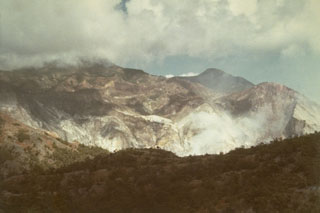 Steam clouds rise above a fumarole field on the flank of Gunung Sirung, south of Airmama village. The crater walls contain extensive areas of light-colored hydrothermally altered rock.
Steam clouds rise above a fumarole field on the flank of Gunung Sirung, south of Airmama village. The crater walls contain extensive areas of light-colored hydrothermally altered rock. 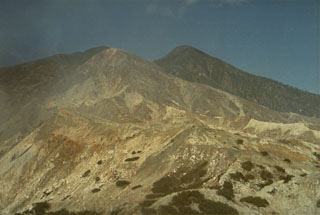 Sirung volcano, seen here from the north, lies at the NE end of a 14-km-long line of volcanic centers forming a peninsula at the southern end of Pantar Island. A 2-km-wide caldera at the summit has been the source of small phreatic eruptions during the 20th century. A lava dome (right) forms the 862-m-high summit of the volcano at the west side of the caldera.
Sirung volcano, seen here from the north, lies at the NE end of a 14-km-long line of volcanic centers forming a peninsula at the southern end of Pantar Island. A 2-km-wide caldera at the summit has been the source of small phreatic eruptions during the 20th century. A lava dome (right) forms the 862-m-high summit of the volcano at the west side of the caldera. The steaming summit caldera of Gunung Sirung volcano is seen here from the eastern caldera rim. Sirung volcano lies at the NE end of a 14-km-long line of volcanic centers forming a peninsula at the southern end of Pantar Island. A lava dome (center) at the western side of the caldera forms the summit of Gunung Sirung volcano; other cones along the chain to the SE increase in height. The 2-km-wide summit caldera has been the source of small phreatic eruptions during the 20th century.
The steaming summit caldera of Gunung Sirung volcano is seen here from the eastern caldera rim. Sirung volcano lies at the NE end of a 14-km-long line of volcanic centers forming a peninsula at the southern end of Pantar Island. A lava dome (center) at the western side of the caldera forms the summit of Gunung Sirung volcano; other cones along the chain to the SE increase in height. The 2-km-wide summit caldera has been the source of small phreatic eruptions during the 20th century.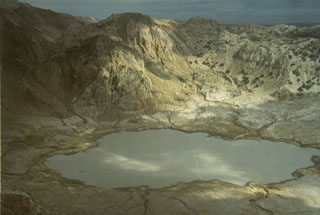 The summit of 862-m-high Gunung Sirung volcano on Pantar Island is truncated by a 2-km wide caldera whose floor often contains one or more small lakes. A number of small phreatic eruptions have taken place in the 20th century from vents inside the caldera.
The summit of 862-m-high Gunung Sirung volcano on Pantar Island is truncated by a 2-km wide caldera whose floor often contains one or more small lakes. A number of small phreatic eruptions have taken place in the 20th century from vents inside the caldera.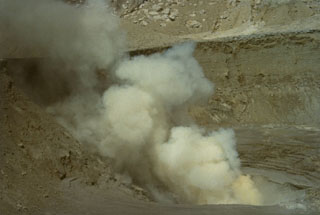 Steam rises from a fumarole in the crater complex B, seen here from the NE. The summit of Gunung Sirung is cut by many craters and explosion pits, five of which contain lakes.
Steam rises from a fumarole in the crater complex B, seen here from the NE. The summit of Gunung Sirung is cut by many craters and explosion pits, five of which contain lakes.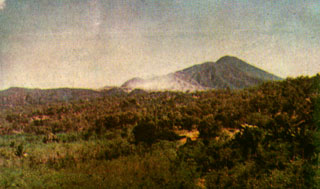 The Gunung Sirung volcanic massif rises to the south of the villages of Kaka and Mauta. The historically active cone is located at the NE end of a 14-km-long chain of volcanic centers that forms a peninsula extending south into the Sawu Sea. The light-colored area (right center) is a fumarole field near Airmama village. Gunung Sopak, the 1318 m high point of the massif, forms the peak at the upper right.
The Gunung Sirung volcanic massif rises to the south of the villages of Kaka and Mauta. The historically active cone is located at the NE end of a 14-km-long chain of volcanic centers that forms a peninsula extending south into the Sawu Sea. The light-colored area (right center) is a fumarole field near Airmama village. Gunung Sopak, the 1318 m high point of the massif, forms the peak at the upper right.The maps shown below have been scanned from the GVP map archives and include the volcano on this page. Clicking on the small images will load the full 300 dpi map. Very small-scale maps (such as world maps) are not included. The maps database originated over 30 years ago, but was only recently updated and connected to our main database. We welcome users to tell us if they see incorrect information or other problems with the maps; please use the Contact GVP link at the bottom of the page to send us email.
There are no samples for Sirung in the Smithsonian's NMNH Department of Mineral Sciences Rock and Ore collection.
| Copernicus Browser | The Copernicus Browser replaced the Sentinel Hub Playground browser in 2023, to provide access to Earth observation archives from the Copernicus Data Space Ecosystem, the main distribution platform for data from the EU Copernicus missions. |
| MIROVA | Middle InfraRed Observation of Volcanic Activity (MIROVA) is a near real time volcanic hot-spot detection system based on the analysis of MODIS (Moderate Resolution Imaging Spectroradiometer) data. In particular, MIROVA uses the Middle InfraRed Radiation (MIR), measured over target volcanoes, in order to detect, locate and measure the heat radiation sourced from volcanic activity. |
| MODVOLC Thermal Alerts | Using infrared satellite Moderate Resolution Imaging Spectroradiometer (MODIS) data, scientists at the Hawai'i Institute of Geophysics and Planetology, University of Hawai'i, developed an automated system called MODVOLC to map thermal hot-spots in near real time. For each MODIS image, the algorithm automatically scans each 1 km pixel within it to check for high-temperature hot-spots. When one is found the date, time, location, and intensity are recorded. MODIS looks at every square km of the Earth every 48 hours, once during the day and once during the night, and the presence of two MODIS sensors in space allows at least four hot-spot observations every two days. Each day updated global maps are compiled to display the locations of all hot spots detected in the previous 24 hours. There is a drop-down list with volcano names which allow users to 'zoom-in' and examine the distribution of hot-spots at a variety of spatial scales. |
|
WOVOdat
Single Volcano View Temporal Evolution of Unrest Side by Side Volcanoes |
WOVOdat is a database of volcanic unrest; instrumentally and visually recorded changes in seismicity, ground deformation, gas emission, and other parameters from their normal baselines. It is sponsored by the World Organization of Volcano Observatories (WOVO) and presently hosted at the Earth Observatory of Singapore.
GVMID Data on Volcano Monitoring Infrastructure The Global Volcano Monitoring Infrastructure Database GVMID, is aimed at documenting and improving capabilities of volcano monitoring from the ground and space. GVMID should provide a snapshot and baseline view of the techniques and instrumentation that are in place at various volcanoes, which can be use by volcano observatories as reference to setup new monitoring system or improving networks at a specific volcano. These data will allow identification of what monitoring gaps exist, which can be then targeted by remote sensing infrastructure and future instrument deployments. |
| Volcanic Hazard Maps | The IAVCEI Commission on Volcanic Hazards and Risk has a Volcanic Hazard Maps database designed to serve as a resource for hazard mappers (or other interested parties) to explore how common issues in hazard map development have been addressed at different volcanoes, in different countries, for different hazards, and for different intended audiences. In addition to the comprehensive, searchable Volcanic Hazard Maps Database, this website contains information about diversity of volcanic hazard maps, illustrated using examples from the database. This site is for educational purposes related to volcanic hazard maps. Hazard maps found on this website should not be used for emergency purposes. For the most recent, official hazard map for a particular volcano, please seek out the proper institutional authorities on the matter. |
| IRIS seismic stations/networks | Incorporated Research Institutions for Seismology (IRIS) Data Services map showing the location of seismic stations from all available networks (permanent or temporary) within a radius of 0.18° (about 20 km at mid-latitudes) from the given location of Sirung. Users can customize a variety of filters and options in the left panel. Note that if there are no stations are known the map will default to show the entire world with a "No data matched request" error notice. |
| UNAVCO GPS/GNSS stations | Geodetic Data Services map from UNAVCO showing the location of GPS/GNSS stations from all available networks (permanent or temporary) within a radius of 20 km from the given location of Sirung. Users can customize the data search based on station or network names, location, and time window. Requires Adobe Flash Player. |
| DECADE Data | The DECADE portal, still in the developmental stage, serves as an example of the proposed interoperability between The Smithsonian Institution's Global Volcanism Program, the Mapping Gas Emissions (MaGa) Database, and the EarthChem Geochemical Portal. The Deep Earth Carbon Degassing (DECADE) initiative seeks to use new and established technologies to determine accurate global fluxes of volcanic CO2 to the atmosphere, but installing CO2 monitoring networks on 20 of the world's 150 most actively degassing volcanoes. The group uses related laboratory-based studies (direct gas sampling and analysis, melt inclusions) to provide new data for direct degassing of deep earth carbon to the atmosphere. |
| Large Eruptions of Sirung | Information about large Quaternary eruptions (VEI >= 4) is cataloged in the Large Magnitude Explosive Volcanic Eruptions (LaMEVE) database of the Volcano Global Risk Identification and Analysis Project (VOGRIPA). |
| EarthChem | EarthChem develops and maintains databases, software, and services that support the preservation, discovery, access and analysis of geochemical data, and facilitate their integration with the broad array of other available earth science parameters. EarthChem is operated by a joint team of disciplinary scientists, data scientists, data managers and information technology developers who are part of the NSF-funded data facility Integrated Earth Data Applications (IEDA). IEDA is a collaborative effort of EarthChem and the Marine Geoscience Data System (MGDS). |